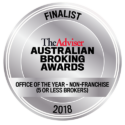Securing a home loan if you are self-employed
Who is considered self-employed
A borrower is considered self-employed when the income they receive, and which is/will be used to repay their loan, comes from working for themselves rather than an employer.
Self-employed applicants include those working as a sole trader or in a partnership, or where their income is generated by a company or trust of which they are a shareholder or unit holder.
Borrowers who are working as PAYG employees of a company they own more than 25% of are also treated as self-employed applicants by lenders.
Self-employed structures can range from very simple such as a sole trader through to complex structures which involve multiple companies and trusts.
Challenges self-employed individuals face when applying for a home loan
The main challenges faced by self-employed individuals are:
- Income documentation: A self-employed borrower must provide different documents than that of a PAYG employee. This can include tax returns, Notice of Assessments, Business Activity Statements (BAS), bank account statements, accountant letters, and income declarations. In some instances, self-employed borrowers may not have all the required documentation ready at the time they need a loan.
- How income is calculated: Calculating and determining a self-employed borrower’s income that can be used by the bank is a more detailed and complex process. In more complex structures, bank credit assessors themselves can have difficulty determining the allowable income which can be used for their borrowing assessment and if not done correctly, can leave the self-employed applicant unable to access the required funds.
- Tax minimisation: Self-employed borrowers will often manage their tax affairs to minimise taxation, however by minimising the taxation they pay this can reduce the income used by the lender and result in a lower loan size that can be approved. There are some expenses of the business, such as interest paid, depreciation, and some one-off expenses which can be added back to the self-employed borrower’s taxable income amount. Self-employed borrowers may also distribute income to other family members using a trust structure, which if not presented correctly to a lender can be excluded from their assessable income.
- Retained earnings: Income received by the self-employed applicant from retained earnings of their company are generally excluded as income for serviceability purposes. Lenders will only allow income earned in the current period for their assessment.
- Retained company profit: Some lenders will not include company profits retained by the self-employed applicant’s business as income for their assessment.
- Company borrowings: Lenders will treat company loans differently, with some lenders also including these commitments against the individual even though they are paid for by the business, resulting in a reduced borrowing capacity.
- Division 7A loans: Lenders treat Div7A loans differently. Some lenders will take these into account in their servicing assessments where other lenders will leave them out. Some lenders will not consider applicants with current Div7A loans.
- Australian Tax Office (ATO) debt: Many lenders will not consider self-employed applicants with current ATO debt and ATO debt under payment arrangement. Some lenders will allow applicants who have ATO debt however will require the debt to be paid out with proceeds of the loan, and other lenders will allow ATO debt under payment arrangement to continue if their assessment shows the self-employed applicant can service this commitment alongside the new loan and any other existing financial commitments.
- Different lender policies and document requirements: Different lenders will have different ways of assessing a self-employed borrower’s income and can have different documentation requirements. Interest rates and other fees and charges can also vary greatly, making it difficult for a self-employed borrower to find the best home loan without the help of an experienced broker.
What is a low doc home loan?
A low doc home loan is a loan product for self-employed borrowers which does not require them to provide the usually required tax returns and Notice of Assessments as evidence of their income.
Documents that may be provided to support a self-employed borrower’s income for a low doc home loan include Business Activity Statements (BAS), bank account statements, accountants’ letters and income declarations.
Low doc home loans often come with restrictions on loan-to-value ratios (LVR) and maximum loan sizes, as well as higher interest rates, fees, and charges.
There are a large range of lenders in the market offering low doc home loans for self-employed individuals. They differ greatly in terms of documentation requirements as well as interest rates and fees.
A low doc home loan is often used as a stepping stone until a self-employed borrower has their financial documents up to date and can qualify for a full doc home loan with a lower interest rate and fees.
What documents do you need for a self-employed home loan application?
There are standard documents required on all applications, regardless of whether the applicant/s are self-employed or PAYG. These include identification documents, statements for existing liabilities, and evidence of assets such as council rates notices for property/s the applicant owns.
The main difference is around income documentation a lender will require to assess a self-employed borrower’s home loan application.
Full Doc Loans: Require the self-employed applicant to provide two full financial years of up to date (current) tax returns and Notice of Assessments (NOA) from the Australian Tax Office (ATO). Most lenders will also require an ATO tax portal to show the self-employed applicants tax liabilities are up to date. Some lenders will also want to see documents that show the applicant has the funds available to meet any current ATO liabilities which are not yet due.
Alt Doc Loans: Where two full financial years of up to date (current) tax returns and Notice of Assessments (NOA) from the Australian Tax Office (ATO) are not available, some lenders will consider one or a combination of alternative documents to support the self-employed applicant’s income. These documents could include Business Activity Statements (BAS), bank statements, accountants’ letters, and income declarations.
Low Doc Loans: This term is often used interchangeably with Alt Doc loans. Low doc is where little or even no documentation is required to evidence income. Alt doc and low doc loans often carry higher interest rates and fees/charges. A low doc loan may only require one income evidence document or fewer Business Activity Statements or a shorter period of bank statements than an Alt Doc loan.
Self-employed home loans made simple
Compared to a salaried employee on a PAYG income seeking a home loan, the options for a self-employed borrower can range from relatively straight forward to incredibly complex. The key is to get the numbers right.
- Engage a broker who is experienced with complex self-employed transactions. While most brokers will deal with self-employed clients, you want to go with a broker who is highly experienced and confident in this space. For experienced brokers, is it common for lender credit assessors to be less experienced with the intricacies of self-employed income and their own lending policy than the broker themselves.
- Timing. Most lenders will require your most recent financials and tax returns from 1st January, with some lenders extending their cut-off past this deadline. It also helps to discuss your borrowing plans for the next year with your accountant prior to June 30, so you have time to do tax planning in a way that meets your borrowing needs. This may involve a higher taxable income and paying more tax in order to meet your borrowing requirements.
- Up-to-date financials. Having up-to-date financials will give you access to the highest number of possible lender options.
- Ensure tax liabilities are up to date. Lenders will generally look unfavourably on an unpaid tax debt, so you will have more options available to you if your tax obligations are managed well.
Unfortunately, when it comes to self-employed home loans, simple is not a word used in the same sentence. However, having the right team on your side will certainly make things as easy as possible, and help you avoid or manage any potential issues along the way.





